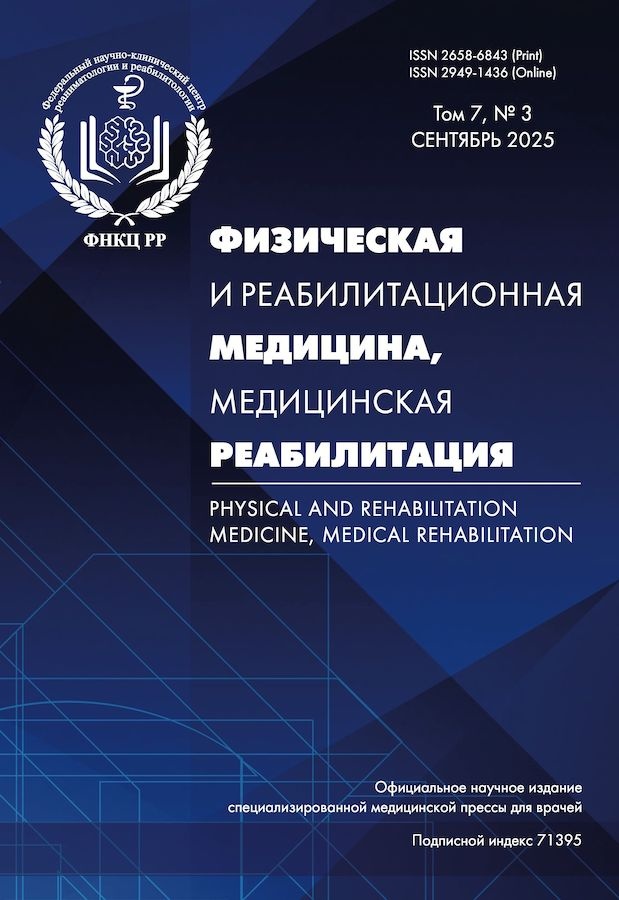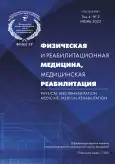Особенности проведения пластики послеоперационных дефектов костей свода черепа у пациентов на различных этапах реабилитации
- Авторы: Варюхина М.Д.1, Воробьёв А.Н.1, Левин Д.В.1, Ильина А.А.1, Колесов Д.Л.1, Шайбак А.А.1, Радутная М.Л.1, Яковлев А.А.1, Горелова Е.С.2
-
Учреждения:
- Федеральное государственное бюджетное научное учреждение «Федеральный научно-клинический центр реаниматологии и реабилитологии»
- Федеральное государственное автономное образовательное учреждение высшего образования «Российский национальный исследовательский медицинский университет им. Н.И. Пирогова» Минздрава России
- Выпуск: Том 4, № 2 (2022)
- Страницы: 83-89
- Раздел: ОРИГИНАЛЬНОЕ ИССЛЕДОВАНИЕ
- URL: https://bakhtiniada.ru/2658-6843/article/view/108760
- DOI: https://doi.org/10.36425/rehab108760
- ID: 108760
Цитировать
Полный текст
Аннотация
Обоснование. Послеоперационные дефекты костей свода черепа являются актуальной проблемой нейрореабилитации, поскольку существенно ограничивают объем реабилитационных мероприятий, осложняют уход за пациентами и ведут к развитию вторичных осложнений, что негативно сказывается на реабилитационном потенциале пациентов. Существенные риски послеоперационных осложнений вынуждают принимать решение об операции индивидуально в каждом случае, в связи с чем сроки проведения краниопластики широко варьируют, и до сих пор остаются предметом дискуссий в научной среде. Цель исследования — сформулировать особенности проведения пластики дефектов костей свода черепа у пациентов на различных этапах реабилитации с учетом проведенного анализа частоты и структуры послеоперационных хирургических осложнений. Материал и методы. Выполнен ретроспективный анализ результатов реконструкций костей свода черепа, проведенных в ФНКЦ РР 129 пациентам с 2018 по 2022 г., на различных этапах реабилитации (реанимационном, стационарном, амбулаторном); обобщены особенности проведения хирургических вмешательств; проанализированы частота и структура хирургических осложнений, характерные для каждого из этапов реабилитации. Результаты. Всего в исследование были включены 129 пациентов, из них мужчин 84 (65%), женщин — 45 (35%); средний возраст — 43,2±13,9 лет. Средний срок выполнения пластики дефекта костей черепа — 79 сут [IQR 60; 133]. На реанимационном этапе реабилитации были прооперированы 72 (56%) пациента, на стационарном и амбулаторном этапах — 40 (31%) и 17 (13%) соответственно. Осложнения отмечены в 16 (12%) случаях. Пациенты на реанимационном этапе реабилитации требовали тщательной предоперационной подготовки, коррекции характерных нарушений гомеостаза и метаболизма. Послеоперационные осложнения выявлены у 12 (17%) пациентов реанимационного профиля; все случаи гидроцефалии встречались только у реанимационных пациентов. У пациентов, прооперированных на стационарном этапе реабилитации, осложнения встречались в 4 (10%) случаях, при этом статистически значимой разницы в частоте развития осложнений у пациентов из реанимационной и стационарной подгрупп не отмечено (p=0,334). Осложнения у пациентов на амбулаторном этапе реабилитации в нашей серии наблюдений не встречались. Заключение. Проведение реконструкций костей свода черепа возможно даже у соматически отягощенных пациентов на реанимационном этапе реабилитации, что позволяет в дальнейшем расширить объем реабилитационных мероприятий у данной категории пациентов и облегчить медицинский уход. При планировании хирургического вмешательства в ранние сроки после образования костного дефекта важно учитывать повышенный риск манифестации гидроцефалии на фоне восстановления костей свода черепа, и учитывать возможную потребность в ликворошунтирующей операции.
Ключевые слова
Полный текст
Открыть статью на сайте журналаОб авторах
Мария Дмитриевна Варюхина
Федеральное государственное бюджетное научное учреждение «Федеральный научно-клинический центр реаниматологии и реабилитологии»
Email: mvaryuhina@fnkcrr.ru
ORCID iD: 0000-0001-8870-7649
SPIN-код: 7463-4645
MD
Россия, 141534, Московская область, Солнечногорский район, д. Лыткино, д. 777, корп. 1Алексей Николаевич Воробьёв
Федеральное государственное бюджетное научное учреждение «Федеральный научно-клинический центр реаниматологии и реабилитологии»
Email: avorobyev@fnkcrr.ru
ORCID iD: 0000-0003-3742-6171
SPIN-код: 3253-7996
MD
Россия, 141534, Московская область, Солнечногорский район, д. Лыткино, д. 777, корп. 1Дмитрий Витальевич Левин
Федеральное государственное бюджетное научное учреждение «Федеральный научно-клинический центр реаниматологии и реабилитологии»
Email: dlevin@fnkcrr.ru
SPIN-код: 2930-4424
MD
Россия, 141534, Московская область, Солнечногорский район, д. Лыткино, д. 777, корп. 1Анна Александровна Ильина
Федеральное государственное бюджетное научное учреждение «Федеральный научно-клинический центр реаниматологии и реабилитологии»
Email: shishova-1992@mail.ru
ORCID iD: 0000-0001-6188-870X
SPIN-код: 1200-3966
MD
Россия, 141534, Московская область, Солнечногорский район, д. Лыткино, д. 777, корп. 1Дмитрий Львович Колесов
Федеральное государственное бюджетное научное учреждение «Федеральный научно-клинический центр реаниматологии и реабилитологии»
Email: dimoz@yandex.ru
ORCID iD: 0000-0002-8450-5211
SPIN-код: 1016-1374
MD
Россия, 141534, Московская область, Солнечногорский район, д. Лыткино, д. 777, корп. 1Александр Анатольевич Шайбак
Федеральное государственное бюджетное научное учреждение «Федеральный научно-клинический центр реаниматологии и реабилитологии»
Email: shaybak@mail.ru
ORCID iD: 0000-0003-0087-1466
SPIN-код: 8544-5407
MD
Россия, 141534, Московская область, Солнечногорский район, д. Лыткино, д. 777, корп. 1Маргарита Леонидовна Радутная
Федеральное государственное бюджетное научное учреждение «Федеральный научно-клинический центр реаниматологии и реабилитологии»
Email: mradutnaya@fnkcrr.ru
ORCID iD: 0000-0002-9181-2295
MD
Россия, 141534, Московская область, Солнечногорский район, д. Лыткино, д. 777, корп. 1Алексей Александрович Яковлев
Федеральное государственное бюджетное научное учреждение «Федеральный научно-клинический центр реаниматологии и реабилитологии»
Email: ayakovlev@fnkcrr.ru
ORCID iD: 0000-0002-8482-1249
SPIN-код: 2783-9692
к.м.н.
Россия, 141534, Московская область, Солнечногорский район, д. Лыткино, д. 777, корп. 1Елена Сергеевна Горелова
Федеральное государственное автономное образовательное учреждение высшего образования «Российский национальный исследовательский медицинский университет им. Н.И. Пирогова» Минздрава России
Автор, ответственный за переписку.
Email: esgorelova@bk.ru
ORCID iD: 0000-0002-5152-6681
Россия, 141534, Московская область, Солнечногорский район, д. Лыткино, д. 777, корп. 1
Список литературы
- Ashayeri K, Jackson EM, Huang J, et al. Syndrome of the trephined: a systematic review. Neurosurgery. 2016; 79:525–533. doi: 10.1227/NEU.0000000000001366
- Honeybul S, Janzen C, Kruger K, Ho KM. The impact of cranioplasty on neurological function. Br J Neurosurg. 2013;27:636–641. doi: 10.3109/02688697.2013.817532
- Dujovny M, Fernandez P, Alperin N, et al. Post-cranioplasty cerebrospinal fluid hydrodynamic changes: magnetic resonance imaging quantitative analysis. Neurol Res. 1997;19:311–316. doi: 10.1080/01616412.1997.11740818
- Malcolm JG, Rindler RS, Chu JK, et al. Complications following cranioplasty and relationship to timing: a systematic review and meta-analysis. J Clin Neurosci. 2016;33:39–51. doi: 10.1016/j.jocn.2016.04.017
- Kim SP, Kang DS, Cheong JH, et al. Clinical analysis of epidural fluid collection as a complication after cranioplasty. J Korean Neurosurg Soc. 2014;56:410–418. doi: 10.3340/jkns.2014.56.5.410
- Aloraidi A, Alkhaibary A, Alharbi A, et al. Effect of cranioplasty timing on the functional neurological outcome and postoperative complications. Surg Neurol Int. 2021;12:1–8. doi: 10.25259/SNI_802_2020
- Le C, Guppy KH, Axelrod YV, et al. Lower complication rates for cranioplasty with peri-operative bundle. Clin Neurol Neurosurg. 2014;120:41–44. doi: 10.1016/j.clineuro.2014.02.009
Дополнительные файлы








